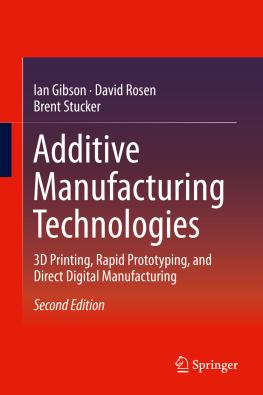Springer Science+Business Media Singapore 2017
David Ian Wimpenny , Pulak M. Pandey and L. Jyothish Kumar (eds.) Advances in 3D Printing & Additive Manufacturing Technologies 10.1007/978-981-10-0812-2_1
Influence of Process Parameters on Tensile Strength of Additive Manufactured Polymer Parts Using Taguchi Method
K. Swarna Lakshmi 1 and G. Arumaikkannu 1
(1)
Department of Manufacturing Engineering, College of Engineering Guindy, Anna University, Chennai, India
Abstract
Selective laser sintering (SLS) is a powder-based additive manufacturing technology in which powder particles fuse using CO2 laser. In this work, the influence of various parameters at various levels is studied experimentally. In this work, the components were designed and fabricated as per ASTM standards. Experiments were designed based on Taguchis design of experiment. An L27 Orthogonal array of Taguchi design was used. In order to determine the significance and contribution of each factor on the tensile strength, analysis of variance (ANOVA) was performed. The results determine that layer thickness and fill scan spacing are significant parameters that cause appreciable improvement in tensile strength.
Keywords
Polyamide Selective laser sintering Taguchi
Introduction
Additive manufacturing (AM) technology has been implemented in many industrial sectorsparticularly in the field of medicine and health care. SLS is one of the most popular AM process used for orthopedic and dental applications. Polymers have been widely used in the SLS process []. Apart from the attempts made earlier in this work, various parameters were analyzed that can influence the tensile strength of the PA 12 parts.
In the present work, a trial has been made to study the outcome of fill scan spacing on the strength of SLS parts using polyamide (PA12) powder. Tensile test specimens are fabricated in various fill scan spacing ranges. Fabricated test specimens are tested for ultimate tensile strength on universal testing machines.
Experimental Setup
2.1 Specimen Characteristics
Polyamide powder (PA12) tensile specimen, 115 6 4 mm3, as suggested by ASTM standard of D638 was used for the experiments. This material was selected for the experiments as it can be used for medical applications. Also this has some advantages such as increased stiffness and heat resistance.
2.2 Sintering Parameters
Layer thickness, fill scan spacing, and orientation were the variables chosen for this work because from previous research [] it was observed that these variables had the most influence on the surface roughness. A low, medium, and high level was selected for each of the sintering to have wide range of combinations.
2.3 Equipment Characteristics
SLS Sinter station 2500+ was used for the sintering operations whose build dimension is 381 330 457 mm. Selective laser sintering (SLS) is an additive manufacturing technique that uses a high-power carbon dioxide laser which selectively fuses small particles to the desired 3D shape based on the 3D CAD model.
2.4 Design of Experiments
An efficient method of experimental planning is design of experiments (DoE) , which incorporates the orthogonal array developed by taguchi to collect statistically significant data with the minimum possible number of repetitions. Here L27 array was selected, and the levels of the parameter are displayed in Table .
Table 1
Levels of process parameters
Exp. no | Layer thickness (mm) | Fill scan spacing (mm) | Orientation () | Tensile strength (N/mm2) | S/N ratio |
|---|
| 0.1 | 0.14 | | 0.8485 | 1.42696 |
| 0.1 | 0.14 | | 0.7765 | 2.19717 |
| 0.1 | 0.14 | | 0.5645 | 4.96672 |
| 0.1 | 0.15 | | 0.503 | 5.96864 |
| 0.1 | 0.15 | | 0.9075 | 0.84307 |
| 0.1 | 0.15 | | 0.944 | 0.50056 |
| 0.1 | 0.16 | | 0.808 | 1.85177 |
| 0.1 | 0.16 | | 0.6845 | 3.29253 |
| 0.1 | 0.16 | | 0.9055 | 0.86223 |
| 0.13 | 0.14 | | 0.8975 | 0.93931 |
| 0.13 | 0.14 | | 0.936 | 0.57448 |
| 0.13 | 0.14 | | 1.23 | 0.407226 |
| 0.13 | 0.15 | | 0.918 | 0.62567 |
| 0.13 | 0.15 | | 0.761 | 2.37231 |
| 0.13 | 0.15 | | 0.67925 | 3.35941 |
| 0.13 | 0.16 | | 0.5975 | 4.47324 |
| 0.13 | 0.16 | | 0.8395 | 1.51959 |
| 0.13 | 0.16 | | 0.909 | 0.82872 |
| 0.15 | 0.14 | | 0.8325 | 1.59232 |
| 0.15 | 0.14 | | 0.932 | 0.61168 |
| 0.15 | 0.14 | | 0.9485 | 0.45925 |
| 0.15 | 0.15 | | 0.9625 | 0.33199 |
| 0.15 | 0.15 | | 0.884 | 1.07095 |
| 0.15 | 0.15 | | 0.7825 | 2.13031 |
| 0.15 | 0.16 | | 0.8145 | 3.39464 |
| 0.15 | 0.16 | | 0.8975 | 0.93931 |
| 0.15 | 0.16 | | 0.8235 | 1.68673 |
2.5 Experimental Procedure
A tensile testing machine (Associated Scientific Engg. Works, New Delhi) with a testing load range of max 5 ton with a gear rotation speed (for gradual loading) of 0.25, 1.5, and 2.5 mm/min was used to measure the tensile strength of the specimen. Figure . The ANOVA was performed considering the process parameters as factors and tensile strength as response.












